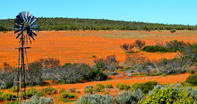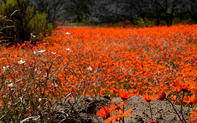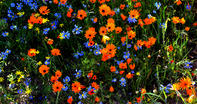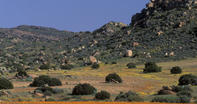The Flower Spotting Route
A very popular stop on the flower-spotting route, the Namaqua National Park is a special place indeed. The main entrance is located about 22 km to the west of Kamieskroon, on good quality gravel roads.

Alternatively, it can be accessed from the slightly rougher Messelpad leading down from Springbok (follow signs for Kanariesfontein, or keep on the Messelpad and drive over the spectacular Wildeperdhoek Pass to enter the park from the rear). The well-known Skilpad (Tortoise) wildflower garden is situated next to the main gate.
Originally established by the World Wildlife Fund for Nature in 1988, this is a reliable place to view some flower ‘carpets’ since it is located in a topographical bowl that effectively captures the moisture blowing in off the sea. The park works to keep this garden blooming by bringing in sheep and goats to graze away the secondary vegetation every couple of years.
Skilpad Rest Camp

A nice circular driving route around the Skilpad section in the Namaqua National Park has been laid out, which is suitable for all vehicles, and the park manager posts regular flower updates on the park website. Several walking trails through the flowers have also been established. The park contains about 3000 recorded plant species and 1500 of these can be found in the Skilpad section alone, so it’s well worth a visit.
There is currently no camping in the park, and the only overnight accommodation is at the stunning Skilpad rest camp. This consists of four newly-built chalets (one of which is wheel-chair friendly) that look out over a breathtaking valley. It’s an amazing location that offers unforgettable views in any season. The chalets are fully equipped for self-catering and can sleep up to 4 people (2 single beds and a double sleeper couch).
There are no restaurants within the park, but there is a little hut called the ‘Pannekoek Paleis’ (Pancake Palace) on the road leading up to the main gate. The operating hours of this facility are somewhat erratic, however. There is also a private farm that abuts the main reception area with a farm stall, which sells curios and snacks.
In season, the local community sometimes operates a traditional ‘kookskerm’ at the reception area that offers visitors a taste of traditional Nama-style cooking. Otherwise, bring along your own food and enjoy an al-fresco meal in the picnic area.
Community and Education

Educationally speaking, the Namaqua National park has a resource center with good displays on the reserve’s flora and fauna. Dormitory accommodation for school groups is available and this facility is used to educate local people about the park’s conservation initiatives.
Community outreach programmes are an integral part of the park’s activities, and considerable progress has been made in this regard despite the scattered nature of the park’s far-flung constituents. Although the park is not rich in big game species, there are several iconic animals to be spotted within the reserve.
These include the Namaqua Speckled Padloper (the world’s smallest tortoise), the Namaqua dune molerat, the Bat Eared Fox and the elusive caracal. Birders will be in their element with over 100 species recorded, and a breeding pair of booted eagles who nest in the tall trees opposite the main reception block every year.
A Beautiful Reserve

All in all, the beautiful Namaqua National reserve is one to watch. It is classed as a ‘developing’ park and, as such, there are lots of projects on the go. The first, and most important, task at hand is expanding the size of the current conservation area. This has been a relatively easy process as there are no land claims in the region and the land is reasonably cheap.
Accordingly, a large number of private farms have already been bought by SAN Parks and several others are under negotiation. De Beers, who own a huge chunk of un-mined territory along the coast between the Spoeg River mouth and the Groen River mouth, are also about to sell their land to the park, which will extend the reserve from the mountains all the way to the ocean.
Original Conservation Area

So, from an original conservation area of just under 1000 ha, the Namaqua National park has grown to over 100,000 ha. Soon, it will cover about 150,000 ha and, when it’s all done, it will be around 200,000 ha, making it the third or fourth largest park in the country. The boundaries of the park will also be extended into the sea to create a large marine reserve of around 1 million ha. In the coming years, the park will be developing additional rest camps, campsites, walking trails and a five-day hiking trail along the coast.
The establishment of horse riding trails, mountain bike trails and a multi-day 4x4 trail along the pristine shoreline are also being investigated. There are already a number of rough and ready 4x4 roads that will take you through the park and these can be used, with permission, to visit the settlements of Soebatsfontein, Kommagas or the Wildeperdhoek Pass.
Bernard van Lente, the enthusiastic park manager, is visibly excited by the park’s potential. As he told me, the biodiversity within the reserve is unequalled, the landscape is gorgeous and the local community is supportive. Here’s hoping the park goes from strength to strength.
By David Fleminger Activities on the Richtersveld Route include hiking, 4x4 trails, bird watching, mountain biking and donkey-cart rides. The Richtersveld Rout...
Activities on the Richtersveld Route include hiking, 4x4 trails, bird watching, mountain biking and donkey-cart rides. The Richtersveld Rout...